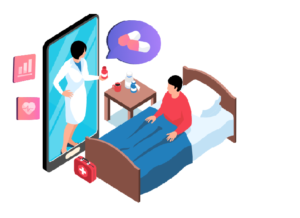Introduction
In today’s fast-paced world, healthcare facilities are constantly looking for ways to improve efficiency and patient satisfaction. One of the most effective solutions to streamline hospital operations is the integration of chatbot technology into the appointment scheduling system. This blog explores the benefits of automating your hospital’s appointment system with a chatbot, how it works, and the positive impact it can have on both patients and staff.
What is a Hospital Appointment Chatbot?
A hospital appointment chatbot is an AI-powered tool designed to assist patients in scheduling, rescheduling, and canceling medical appointments. These chatbots can be integrated into a hospital’s website, mobile app, or social media platforms, providing 24/7 assistance and ensuring that patients can manage their appointments at their convenience.
Benefits of Using a Chatbot for Appointment Scheduling

1. Enhanced Patient Experience
Patients appreciate the convenience and speed of chatbots. Instead of waiting on hold or navigating through complex phone menus, they can quickly book an appointment with just a few clicks or taps. Chatbots provide instant responses, which is particularly beneficial for those seeking immediate care or information. Overall, chatbots enhance patient satisfaction by streamlining the booking process.
2. Increased Efficiency
Automating the appointment scheduling process with a chatbot significantly reduces the workload on hospital staff. By managing routine tasks like booking, rescheduling, and canceling appointments, chatbots allow staff to focus on more complex and urgent matters. This boosts hospital efficiency and cuts down patient waiting times, leading to a smoother, faster experience for everyone involved.
3. Reduced No-Shows
Chatbots can send automated reminders to patients about their upcoming appointments via text message, email, or through the chatbot itself. By reducing the number of missed appointments, hospitals can enhance their overall efficiency. This ensures that more patients receive the care they need, minimizing gaps in the schedule. Automated reminders contribute to better patient adherence and smoother hospital operations. This functionality helps maintain a steady flow of appointments, improving patient care and resource utilization.
4. 24/7 Availability
Chatbots are available 24/7, unlike human staff. This allows patients to schedule appointments at any time, even outside regular office hours. The continuous availability ensures patients always have access to healthcare services, crucial in emergencies or for those with busy schedules. This round-the-clock service enhances convenience and accessibility for all patients.
5. Data Collection and Analysis
Chatbots can collect valuable data on patient interactions, appointment patterns, and common inquiries. This data can be analyzed to identify trends and optimize scheduling practices. Hospitals can use these insights to improve patient care and make data-driven decisions. By leveraging this information, healthcare facilities can enhance overall operations and boost patient satisfaction. The analysis of chatbot-collected data helps refine services, making them more efficient and responsive to patient needs.
How Does a Hospital Appointment Chatbot Work?
1. Natural Language Processing (NLP)
Chatbots leverage NLP for understanding patient requests, ensuring a seamless, human-like interaction. NLP processes language nuances, aiding in interpreting inquiries accurately. This technology enhances the chatbot’s ability to respond intuitively to patients. By mimicking human conversation, it creates a comfortable and efficient interaction. Overall, NLP-driven chatbots revolutionize patient interactions, enhancing user experience and healthcare efficiency.
2. Integration with Hospital Systems
To manage appointments efficiently, a chatbot must integrate with the hospital’s systems, like EHR and scheduling software. This integration grants real-time access to appointment availability and patient records. It enables the chatbot to provide accurate information and schedule appointments seamlessly. By tapping into existing systems, the chatbot ensures data consistency and reliability. Patients benefit from streamlined appointment booking and updated information. Overall, this integration enhances the chatbot’s ability to manage appointments effectively within the healthcare setting.
3. User-Friendly Interface
A well-designed chatbot features a user-friendly interface for scheduling, using text prompts and clickable options. Visual aids are incorporated to enhance clarity and simplicity for patients. The interface guides users through the scheduling process seamlessly. By offering intuitive navigation, the chatbot ensures a straightforward experience. This design approach prioritizes user convenience and ease of use. Overall, it fosters efficient interaction and enhances the scheduling process.
4. Secure Data Handling
Ensuring patient privacy, chatbots in healthcare adhere to regulations like HIPAA for secure data handling. Compliance involves encryption, safeguarding data in transit and at rest. Secure authentication methods are employed to restrict unauthorized access to patient information. Regular audits monitor and maintain data protection measures. These efforts aim to prevent data breaches and uphold patient confidentiality. By implementing HIPAA standards, chatbots contribute to a trustworthy and secure healthcare environment.
Implementing a Chatbot in Your Hospital
1. Identify Needs and Goals
Before deploying a chatbot, assess your hospital’s unique needs and objectives thoroughly. Evaluate appointment volumes, prevalent patient queries, and challenges in scheduling. Identify key pain points and areas where automation can enhance efficiency. Tailor the chatbot’s functionality to address these specific needs effectively. Consider integrating with existing systems for seamless operation. By aligning the chatbot’s capabilities with hospital goals, you maximize its impact on improving patient experience and streamlining operations.

2. Choose the Right Chatbot Solution
Choose a chatbot solution that aligns with your hospital’s needs, prioritizing NLP capabilities for natural language understanding. Ensure seamless integration with existing systems to maximize efficiency. Prioritize solutions that comply with healthcare regulations like HIPAA for data security. Look for features that enhance user experience and streamline processes. Evaluate scalability and customization options to meet evolving requirements. Selecting the right chatbot solution contributes significantly to optimizing hospital operations and patient interactions.
3. Training and Customization
Customize the chatbot to embody your hospital’s brand identity and showcase its services effectively. Train the chatbot using relevant data to handle patient inquiries accurately and provide valuable information. Incorporate hospital-specific terminology and policies for clarity and consistency in responses. Regularly update the chatbot’s knowledge base to stay current with new information and services. Ensure the chatbot reflects the hospital’s values and commitment to patient care in its interactions. A well-trained and customized chatbot enhances the hospital’s online presence and user experience.
4. Pilot and Monitor
Begin with a pilot program to assess the chatbot’s functionality and gather feedback from patients and staff. Monitor its performance closely to identify strengths and areas for improvement. Use feedback to make necessary adjustments and enhancements to enhance effectiveness. Continuously evaluate user satisfaction and usability to refine the chatbot’s performance. Implement iterative improvements based on feedback and data analysis. This approach ensures the chatbot evolves to meet the hospital’s needs and expectations effectively.
5. Launch and Promote
Upon completion, launch the chatbot on preferred platforms and promote its availability to patients. Utilize social media, email newsletters, and in-hospital signage for effective marketing. Highlight the chatbot’s benefits and convenience to attract user engagement. Monitor user adoption and feedback to gauge effectiveness and make adjustments if needed. Continuously promote the chatbot’s features and encourage its use among patients. This comprehensive approach ensures maximum utilization and benefits from the chatbot solution.
Conclusion
Automating your hospital’s appointment system with a chatbot can transform the way you manage patient interactions. By enhancing efficiency, improving patient experience, and providing 24/7 support, chatbots offer a valuable solution for modern healthcare facilities. Embrace this technology to stay ahead in the competitive healthcare landscape and ensure that your patients receive the best possible care.